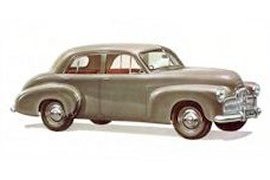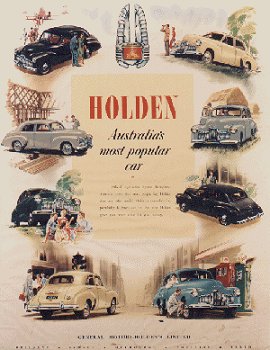

In 1856 James Alexander Holden established a leather and saddlery business on the corner of King William and Rundle Streets in Adelaide, South Australia. in 1885 it combined with the carriage builder Henry Adolf Frost to became the famous "Holden and Frost".
In 1910 Holden & Frost began trimming motor vehicles and in 1914 they built their first one off car body for an imported Lancia chassis. Larger contracts followed but ironically the first major contract was for Dodge bodies (a later competitor).
By 1917 the Australian government had placed an import embargo on complete vehicles, the First World War having almost entirely involved Britain's industry, and German U Boat Captains were doing their best to ensure that very few cargo ships leaving North America reached their intended destination.
These conditions, combined with the need to save valuable cargo space, restricted imports to chassis and forced local vehicle agents to look to local firms to provide the bodies.
In 1919 Edward Wheeldon Holden registered "Holden's Motor Body Builders" as a separate company specialising in car bodies. At the time they built bodies for Overland, Chevrolet, Durant, Hupmobile and Dodge, and by 1923 they were producing over 12,000 bodies per year.
In 1924 "Holden's Motor Body Builders" became the sole Australian body builder for General Motors vehicles and had an output of over 22,000 bodies (over 11,000 for GM) in 65 different body styles.
The famous "Lion and Stone" symbol was designed in 1928 by George Rayner Hoff, and represented the legend of man's invention of the wheel. It was subsequently fitted to all Holden bodies and, although undergoing minor changes over the years, remains to this day.
During the 'Great Depression' in 1930, production fell from 34,000 units per year to a mere 1651 and, in 1931, General Motors were able to buy the entire Holden's Motor Body Builders and merge it with their North American operation to form General Motors - Holdens.
This move was not entirely motivated by taking advantage of the company when it was at an all time low but was mainly occasioned by the Australian government freezing the currency so that money couldn't leave the country during the depression.
The money to pay GM in the United States for the previously imported chassis was trapped in Australia and so was used to finance the buy out which in part took the form of swapping the ordinary shares held by 1550 Australian shareholders in Holdens Motor Body Builders for 561,000 6% 1 pound preference shares (ie: 6% of the value of their shares each year) in the new company.
This made the paid up capital of the new company 561,000 pounds Australian capital (37% of the total) and 965,800 pound U.S. capital (63% of the total).
In addition there was tension between the Australian operation and the United States with management in the United States complaining "Amazing people these Australians; they just won't do as they're told" (Inness Randolph head of General Motors Australia to Larry Hartnett in 1929) and a merger/takeover was also a way to solve this little problem.
In 1934 Larry Hartnett (later Sir Laurence Hartnett) was sent to Australia by GM as Managing Director of the Australian company with a directive to either make it profitable or close it down.
Fortunately Hartnett respected the resourceful nature of the Australian operation and stated "The economies achieved by Holden's at Woodville put them, in many ways, years ahead of the rest of the world in manufacturing techniques. The resourcefulness and initiative of the Australians in this industry is beyond praise."
By 1935 the world economy had strengthened and under the leadership of Larry Hartnett GM-H lifted production to 23,129 bodies and a profit of 650,000 pounds. The company also introduced the "Sloper" to the world which was the fore runner of the hatchback and led the rest of the world in producing the first all steel bodies.
In 1936 Larry Hartnett began planning the complete production of a "wholly Australian car", however another World War intervened, with the (Menzies) government of the time putting these plans on hold. After the war the Government asked for proposals from any local company for production of a complete car - and General Motors Holdens were the only company to reply.
On September 20, 1944 Sir Laurence Hartnett and Mr Jack Horn of General Motors - Holdens made a presentation entitled "Australia - GM's Performance and Results - Manufacture of Complete Motor-Cars in Australia" to the Executive Post War Planning Committee of General Motors in New York. This meeting gained approval in principal for GM-H to commence the process of designing and building an Australian car.

A major production which was rehearsed for 3 weeks in New York and involved 18 stenographers, 7 photographers and photographic reproduction men, 2 statisticians plus experts from GM finance, materials and manufacturing divisions all with the aim of convincing the committee of approving the project in principal, it was finally approved in November 1944.
But it almost did not eventuate, with the US deciding that it would not invest in Australia (despite making hefty profits from its Australian operation) and only when the Commonwealth Bank came up with 2,500,000 pounds and the Bank of Adelaide came up with the balance of 500,000 pounds did the project finally get off the ground.
Today, almost every generation X Australian would have owned or driven a Holden at some time and the company can rightfully claim to be 'Australia's Favourite Car'.















